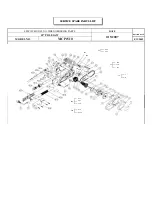
- 4 -
B. If the plug or receptacle does get wet,
DO NOT
unplug the cord. Disconnect the fuse or circuit breaker that
supplies power to the tool. Then, unplug and examine for presence of water in the receptacle.
FOR YOUR OWN SAFETY READ INSTRUCTION
MANUAL BEFORE OPERATING SAW.
• Wear eye protection.
• Use splash hood for every operation for which it can be used.
• Disconnect saw before servicing, when changing cutting wheels, and cleaning.
• Use tool only with smooth edge cutting wheels free of openings and grooves.
• Replace damaged cutting wheel before operating.
• Do not fill water bath above water fill line.
CALIFORNIA PROPOSITION 65
SOME DUST CREATED BY POWER SANDING, SAWING, GRINDING, DRILLING AND OTHER
CONSTRUCTION ACTIVITIES CONTAIN CHEMICALS KNOWN TO THE STATE OF
CALIFORNIA TO CAUSE CANCER, BIRTH DEFECTS OR OTHER REPRODUCTIVE HARM.
Some examples of these chemicals are:
• Lead from lead-based paints,
• Crystalline silica from bricks and cement and other masonry products, and,
• Arsenic and chromium from chemically-treated lumber.
Your risk from these exposures varies, depending on how often you do this type of work. To reduce your
exposure to these chemicals: work in well ventilated area, and work with approved safety equipment, such as
those dust masks that are specifically designed to filter out microscopic particles.
ELECTRICAL REQUIREMENTS
CONNECTING TOOL TO POWER SOURCE OUTLET
• This machine source must be grounded while in use to protect the operator from electrical shock.
• In the event of a malfunction or breakdown, grounding provides a path of least resistance for electrical current
to reduce the risk of electrical shock. The tool is equipped with an electric cord having equipment grounding
conductor and a grounding plug. The plug must be plugged into a matching outlet that is properly installed
and grounded in accordance with all local codes and ordinances.
• Do not modify the plug provided if it will not fit the outlet. Have the proper outlet installed by a
qualified electrician.
• Improper connection of the equipment-grounding conductor can result in a risk of electric shock. The
conductor with insulation having an outer surface that is green (with or without yellow stripes) is the
equipment – grounding conductor to a live terminal.
• Check with a qualified electrician or service personnel if the grounding instructions are not completely
understood, or if in doubt as to whether the tool is properly grounded.
• Use only 3-wire extension cords that have 3-prong grounding plugs and 3-pole receptacles that accept the
tool’s plug.
• Repair or replace damaged or worn cord immediately.
60087_Manual.qxd:60087_Manual 4/23/09 4:04 PM Page 4





























